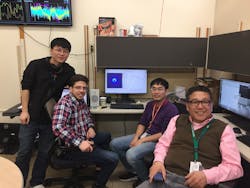Laser excitation helps show how water molecules move
An international team of researchers from the Department of Energy’s SLAC National Accelerator Laboratory (Menlo Park, CA), Stanford University (Stanford, CA), and Stockholm University (Stockholm, Sweden) have directly observed how hydrogen atoms in water molecules tug and push neighboring water molecules when they are excited with laser light. Their results reveal effects that could underpin key aspects of the microscopic origin of water’s properties and could lead to a better understanding of how water helps proteins function in living organisms.
This so-called nuclear quantum effect has been hypothesized to be at the heart of many of water’s strange properties, and now the research team has been able to observe this effect directly, explains Anders Nilsson, a professor of chemical physics at Stockholm University, one of the study collaborators. “The question is if this quantum effect could be the missing link in theoretical models describing the anomalous properties of water,” he says.
Each water molecule contains one oxygen atom and two hydrogen atoms, and a web of hydrogen bonds between positively charged hydrogen atoms in one molecule and negatively charged oxygen atoms in neighboring molecules holds them all together. This intricate network is the driving force behind many of water’s inexplicable properties, but until recently, researchers were unable to directly observe how a water molecule interacts with its neighbors.
“The low mass of the hydrogen atoms accentuates their quantum wave-like behavior,” says collaborator Kelly Gaffney, a scientist at the Stanford PULSE Institute at SLAC. The work directly demonstrates that the response of the hydrogen bond network to an impulse of energy depends critically on the quantum mechanical nature of how the hydrogen atoms are spaced out, which has long been suggested to be responsible for the unique attributes of water and its hydrogen bond network, he adds.
Making this observation has been challenging because the motions of the hydrogen bonds are so tiny and fast. This experiment overcame that problem by using SLAC’s MeV-UED, a high-speed electron camera that detects subtle molecular movements by scattering a powerful beam of electrons off samples.The research team created 100-nm-thick jets of liquid water and set the water molecules vibrating with infrared laser light. Then, they blasted the molecules with short pulses of high-energy electrons from the MeV-UED camera. Doing so generated high-resolution snapshots of the molecules’ shifting atomic structure that they strung together into a stop-motion movie of how the network of water molecules responded to the light.
The snapshots, which focused on groups of three water molecules, revealed that as an excited water molecule starts to vibrate, its hydrogen atoms tug oxygen atoms from neighboring water molecules closer before pushing them away with its newfound strength, expanding the space between the molecules.
“For a long time, researchers have been trying to understand the hydrogen bond network using spectroscopy techniques,” says Jie Yang, a former SLAC scientist and now an associate professor at Tsinghua University (China), who led the study. With their work, however, they were able to directly observe how these molecules move, he says.
The researchers hope to use this method to gain more insight into the quantum nature of hydrogen bonds and the role they play in water’s strange properties, as well as the key role these properties play in many chemical and biological processes.
Full details of the work appear in the journal Nature.

